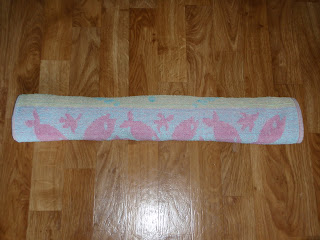I will admit that I do not do a lot of blocking. Since I mostly make socks and small things I have never really seen the point, they get washed (generally in the machine), dried, and get stretched out when they go on my feet.
s
However, I have discovered the importance of blocking when it comes to knitted lace, it makes the difference between a tangly thing with a pattern to a beautiful lace scarf/shawl/whatever. There is a nice, slightly crunchiness to the fabric as well which is quite pleasing and the work sits and flows much better.
s
Obviously then (since I have been wittering on about it) today's technique is going to be about blocking lace, there are, as always with crafting, many variations on how to do this, it is just how I have done my past projects.
ss
Half fill a sink with warm water (not hot), you can add a little wool wash or conditioner as well if you want to, it is personal preference.
Gently lower the work into the sink, pushing it down into the water but not swishing it around (too much movement risks felting, which would be a huge waste!)
s
s
.JPG) s
sLeave the work in the water until it is fully wet or as long as instructed by the wool wash.
Scoop the work out of the water, supporting it with both hands so there are no bits hanging down, these can get stretched by the weight of the water. Drain the sink and gently squish the work against the side of the sink to get as much water out as possible. Don't wring the water out and be really gentle to avoid felting.
Lay the work out on a clean towel, it can be bunched up, but avoid too much twisting.
s
 s
s
Roll the towel into a sausage with the work inside
s
 s
s
Then squeeze the towel sausage with your hands or by stomping on it. This should get most of the water out.
s
s
 s
sRoll the towel into a sausage with the work inside
s
 s
sThen squeeze the towel sausage with your hands or by stomping on it. This should get most of the water out.
s
Lay it out on the blocking surface (I am using a carpet that has a nice squishy foam back, but be careful as the pins and any leaking dye may damage surfaces).
Begin pinning along the edges, smoothing the work out to the desired shape and dimensions as you go. I often pin once, then work along again, getting a bit more stretch in to open out the holes even more. This is all personal choice for how much you want to stretch the work.
Depending on the pattern you may want to try and maintain straight lines as you go, a blocking surface with parallel lines marked on can make this easier.
s

s
Alternatives to pins are just laying the work out for lightly blocked pieces and wires which are threaded through the edges of the work to give a more even stretch and avoid the little points that pins give.
s
 s
s
Alternatives to pins are just laying the work out for lightly blocked pieces and wires which are threaded through the edges of the work to give a more even stretch and avoid the little points that pins give.
s
 s
s The work should be left to dry in its stretched position, then the pins can be removed and the item used/worn/gifted etc
s
While I am unlikely to change my mind about blocking socks I am definitely a convert for lace, it is not too tricky a task and the results are worth it.
While I am unlikely to change my mind about blocking socks I am definitely a convert for lace, it is not too tricky a task and the results are worth it.

Thank you so much for posting this on Creative Friday!
ReplyDeleteWarmly
Linda
I bought some "blocking" boards at Sam's Club. They are supposed to be floor mats but they work great for sticking the pins in. I got plenty of mats for $21 which is a price I can afford.
ReplyDeleteThanks for the instructions.